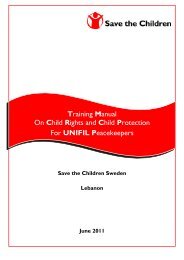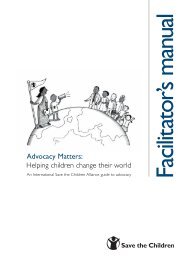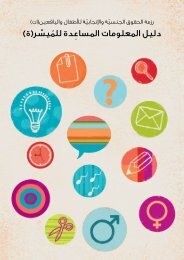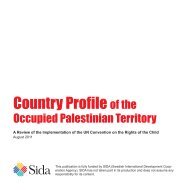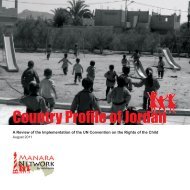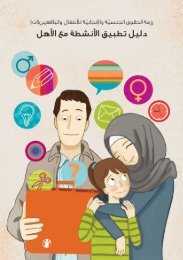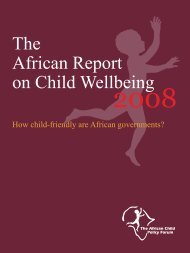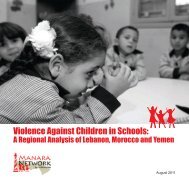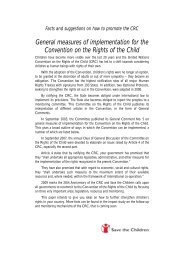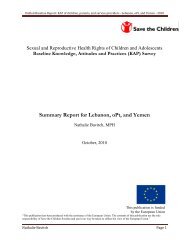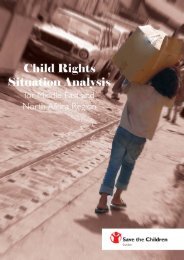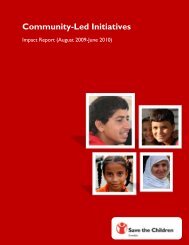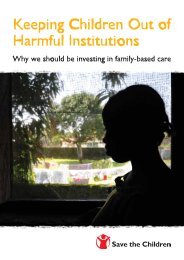Country Profile of Morocco - International Bureau of Children's Rights
Country Profile of Morocco - International Bureau of Children's Rights
Country Profile of Morocco - International Bureau of Children's Rights
You also want an ePaper? Increase the reach of your titles
YUMPU automatically turns print PDFs into web optimized ePapers that Google loves.
“A 2004 study<br />
showed that<br />
even in school,<br />
where corporal punishment<br />
is not permitted,<br />
it is still widely practiced.<br />
In fact, 87% <strong>of</strong><br />
children say they have<br />
been beaten at least<br />
once at school.”<br />
37<br />
allocated to education to<br />
26% <strong>of</strong> the total budget,<br />
an increase <strong>of</strong> 6.9% over<br />
2004.<br />
Before the launch <strong>of</strong> this<br />
plan, and within the National<br />
Charter launched in<br />
2000, the MNE initiated in<br />
2004 a pilot to develop preschool<br />
education by supporting<br />
educators. With the<br />
support <strong>of</strong> French Cooperation,<br />
UNICEF and the<br />
Bernard Van Leer Foun-<br />
dation, the MNE supported the early childhood NGO<br />
ATFALE in the production <strong>of</strong> a pedagogical kit that was<br />
distributed to 120 regional trainers supposed to ensure the<br />
training <strong>of</strong> 2,000 other pre-school educators. 178<br />
Also before the launch <strong>of</strong> the second reform effort and<br />
within the National Charter, five manuals were developed<br />
for subjects taught in the first grade <strong>of</strong> primary school<br />
and distributed in 2005/2006. 179 Also, 128 manuals were<br />
produced for the second and third grades, and two other<br />
manuals produced for the second year <strong>of</strong> college. 180 The<br />
quality <strong>of</strong> these manuals has been questioned, however, by<br />
Moroccan and international NGOs, who say they are not<br />
compatible with the principles <strong>of</strong> equality, freedom, nondiscrimination<br />
and tolerance that <strong>Morocco</strong> is supposed to<br />
respect after ratifying international conventions. 181<br />
e.<br />
Violence Against Children<br />
Like many issues related to children, violence against children<br />
is poorly documented in <strong>Morocco</strong>. 182 According to a<br />
study carried out by the Ministry <strong>of</strong> Justice and UNICEF<br />
in 2005, “violence is present everywhere, even if it is not<br />
documented.” 183<br />
According to the penal code, any person who injures or<br />
hits a child under the age <strong>of</strong> 15, or who purposely denies<br />
health care or medicine to the point <strong>of</strong> compromising the<br />
child’s health, or deliberately commits violence or assault,<br />
excluding minor <strong>of</strong>fenses, on the child, is punishable by<br />
imprisonment from one to three years. In other words,<br />
violence is permissible as long as it only causes light<br />
injury. Regulations (articles 400 to 404) prohibit the use <strong>of</strong><br />
violence against children in schools and in the home. 184<br />
A 2004 study by the MNE showed that even in school,<br />
where corporal punishment is not permitted, it is still<br />
widely practiced. In fact, 87% <strong>of</strong> children say they have<br />
been beaten at least once at school. 185 This same study<br />
showed that parents also resort to corporal punishment<br />
at home, with 61% <strong>of</strong> children saying they have been<br />
beaten by their parents at least once. The study showed<br />
that teachers and parents believe children should fear<br />
them to work and behave better. This belief makes fighting<br />
violence towards children all the more difficult, since<br />
“violence is <strong>of</strong>ten socially-accepted and approved”. 186<br />
In orphanages and other governmental institutions caring<br />
for children, a 2005 report by the Ministry <strong>of</strong> Justice<br />
found that violence is the disciplinary measure used most<br />
<strong>of</strong>ten. 187 Indeed, this report showed that relations between<br />
children and educators in these institutions are based on<br />
physical and psychological violence. 188<br />
Meanwhile, children who work are also vulnerable to<br />
violence. Just like in schools, corporal punishment in<br />
the workplace is regarded by artisans as a way to make<br />
children pay more attention to their work and thus learn<br />
faster. 189 According to a statistical survey on female<br />
domestic workers, adolescent girls are the group most




